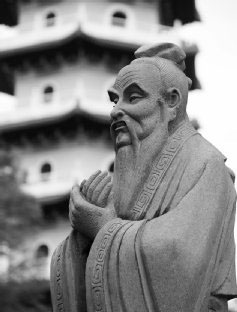Confucius 551 BCE–479 BCEJoseph A. Adler
Joseph A. Adler Joseph A. Adler is professor of Asian studies at Kenyon College in Gambier, Ohio, where he teaches courses on East Asian religions. He received his Ph.D. in Religious Studies from the University of California at Santa Barbara. His published work focuses on the “Neo-Confucian” tradition in Song dynasty China. His latest book, Reconstructing the Confucian Dao: Zhu Xi’s Appropriation of Zhou Dunyi, is nearing completion. The man we call Confucius was the founder of a religio-philosophical tradition that became almost synonymous with Chinese culture. From the second century BCE to the beginning of the 20th century “Confucianism” (Rujiao, literally “the teaching of the scholars”) was the official ideology of the Chinese imperial government and the reigning philosophy of education. As such, its values eventually permeated all levels of Chinese society. Confucius thereby became a 
Statue of the Chinese philosopher Confucius. Confucianism has had a profound impact on Chinese thought and ethics. (Espion/Dreamstime.com) [Full Size] The year of Confucius’s birth is uncertain but is traditionally given as 551 BCE. The Kong family into which he was born was, according to his first biographer, Sima Qian (ca. 145–86 BCE), formerly aristocratic but had been relatively impoverished for generations. He lived during a period of political disunion and constant warfare when the former dukedoms of the Zhou dynasty were vying for power, a situation that lasted until the reunification of China under the Qin state in 221 BCE. Confucius’s given name was Kong Qiu, his “courtesy name” was Kong Zhongni, and he is most commonly referred to in the Chinese literature as Kongzi (Master Kong). “Confucius,” coined by 17th-century Jesuit missionaries in China, is a Latinized form of Kongfuzi, a more honorific form of Master Kong. He had a son who died before he did, ― 770 ― and
a grandson, Kong Ji (483–402 BCE, also known as Zisi), who was an
important figure in the later dissemination of Confucius’s teachings.
Until his early fifties Confucius held a series of minor government positions in his home state of Lu, where he gained a reputation as an expert in court ritual and decorum (li) and had a small coterie of disciples or protégés. In 497 BCE, after one of the disciples, Zi Lu, opposed three powerful families for usurping the proper rulership of the duke of Lu, he and Confucius left Lu along with a few other disciples. Confucius became an itinerant teacher, traveling from state to state seeking a position as advisor to a ruler, a goal he never achieved. Around 484 he returned to Lu, having made something of a name for himself as a teacher of young men wishing to work in government. A few of his students did achieve responsible positions. Confucius lived the remaining five years of his life in Lu, where he died in 479 BCE. After his death, Confucius’s disciples began to record what they remembered of his sayings and conversations, as well as their recollections of his personal behavior. This record came to be known as the Lunyu (Discussions and Sayings), or Analects. Followers added to it for, according to some scholars, more than 200 years. The later chapters are therefore unreliable as sources of what Confucius actually taught, although the entire book, comprising 20 chapters, has traditionally been considered an authentic record of his teachings. By the Han dynasty (206 BCE–220 CE) Confucius had become a sort of patron saint of the teaching profession. Sacrifices were made to him, beginning in his home town of Qufu, Shandong Province, and later in state-supported Confucian temples. Confucius’s teachings were focused on restoring the ritual propriety that he believed had prevailed under the early rulers of the Zhou dynasty (ca. 1045–221 BCE). His moral theories, based on a relational understanding of human nature, became the basis for a comprehensive religious and philosophical worldview accepted by the majority of Chinese literati or intellectuals and many in Korea and Japan. During the Chinese Cultural Revolution (1966–1976) Confucius was held responsible for all that had gone wrong in traditional Chinese culture, such as hierarchical age and sex discrimination. Since the 1980s his image has been gradually rehabilitated, to the point where the People’s Republic of China in the 21st century is supporting Confucius Institutes around the world to spread the teaching of Chinese language and culture. Critics say, however, that the government’s motivation is to use Confucius as he was used since the Han dynasty, to support social order and the status quo. Modern scholars have attempted to separate out this “politicized Confucianism” from the original teachings of Master Kong and his later followers. See also:Confucianism; Indonesia, Confucianism in. References
|